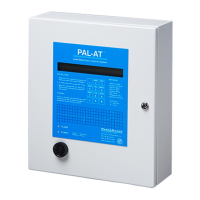PAL-AT Installation Manual
64
6. Reassemble the switch. Carefully alternate the screens and three sensor disks in the cap as shown
in figure 9-3. If there are more than 4 screens, place the extra screens on top. Place the actuator on
top of the top screen. The actuator has a small point in the center of one side that must face the probe
housing as shown. Hold the probe housing vertically and screw the cap finger-tight into the bottom of
the housing.
7. If response time is over 5 minutes for diesel fuel at room temperature, insert the optional fifth screen
next to the actuator. Make sure the extra screen does not activate the probe when it is tightened. If
so, remove the extra screen. The extra screen accommodates manufacturing tolerances and reduces
the amount of swelling of the sensor disks required before the probe activates.
9.4.2 Testing the Probe
The assembled probe can be easily tested with an ohmmeter and a small paperclip.
1. Connect the ohmmeter leads to the probe leads.
2. The reading should be very low, typically under two ohms.
3. Insert the paper clip into one of the five holes in the center of the cap and press gently (1-2 oz of force
[25 g to 50 g]) into the switch.
4. The ohmmeter should read an open circuit or 0.L.
5. Remove the paper clip and the meter should return to the original low reading.
6. Disconnect the ohmmeter.
9.4.3 Troubleshooting
If the test results are not as expected, the following checks should help determine the problem.
If the original reading is greater than 2 ohms or open, or 0.L, then
o Check the sensor disks and screens are installed correctly. They must be flat, not folded
over.
o Verify the diameter has returned to the original size. Clean again if needed.
o Recalibrate the probe as described below.
If the ohmmeter reading is not an open circuit, 0.L, when the paperclip is inserted, then
o Check the meter leads or probe wires are not shorted together.
o Disassemble the probe and make sure the actuator point is oriented properly to press into
the center of the switch in the probe housing.
o Recalibrate the probe as described below.
9.4.4 Calibrating the Probe
If the sensor elements are replaced, it is necessary to use the correct number of screen elements for
optimum sensitivity (see figure 9-3). The number of screens required varies due to manufacturing
tolerances of the probe. A multimeter is required.
1. Set the multimeter to the ohms function, auto-ranging scale, and connect to the probe leads.
2. Assemble the probe with seven screens and three elements as shown. Tighten the cap finger tight.
3. If the meter reading is less than 2 ohms, the probe fails the calibration. Make sure there are no extra
screen or sensor disks installed.
4. If the reading is 0.L, remove a screen (shown by the dashed arrows in figure 9-3). If the reading is less
than 2 ohms, the calibration is complete.
5. If more than four screens are installed repeat step 4.
6. If the reading is 0.L with four screens, the probe fails the calibration. Make sure there are three sensor
disks and at least four screen disks installed.
If the reading in step 4 is not less than 2 ohms, hold the probe in a vertical orientation and gently tap the
housing. The switch resistance should be less than 2 ohms in the normal dry state.

